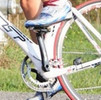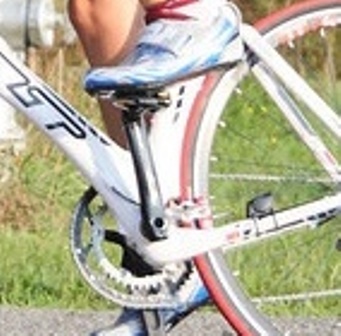How to Pedal More Efficiently: A Guide to Cycling Form, Pedal Stroke, and Bike Fit
Posted by matt russ on 20th Nov 2025
Propelling yourself on a bicycle is a simple concept: push the pedals harder, faster, or both to increase speed. But producing that speed efficiently is a different challenge. Power is only part of the equation—cycling efficiency determines how much of your effort actually turns into forward motion. Even strong, fit athletes may ride more slowly than expected if their pedal stroke, biomechanics, or bike fit is inefficient.
The Pedal–Foot Interface: Foundation of Efficient Power Transfer
Your connection to the crank arm starts at the foot–pedal interface.
For most riders, the widest part of the foot should sit directly over the pedal spindle. While some cyclists prefer a slightly forward or rearward position, aligning between the first and fifth metatarsal heads generally maximizes stability and power transfer.
-
Use a solid shoe platform. Carbon-soled cycling shoes offer superior stiffness, transferring more force than flexible rubber-soled shoes.
-
Ensure a secure fit. Loose shoes waste energy. Keep straps snug and make sure the shoe fits properly.
-
Correct foot tilt only if needed. If your foot naturally tilts inward or outward, force will be directed medially or laterally instead of straight into the crank. Shims can adjust this—but only under guidance from a professional bike fitter.
-
Match cleat rotation to your biomechanics. Avoid locking your foot into an unnatural angle. Systems with ample float help accommodate riders who are naturally pigeon-toed or duck-footed.
Applying Pedal Force: Where Efficient Speed Really Comes From
Optimal pedal force is applied perpendicular to the crank arm. Any force in other directions contributes little to speed.
-
Start producing force early. Efficient cyclists begin applying power around the 1 o’clock position—just over the top of the stroke.
-
Don’t pull up for power. Trying to generate force by pulling up on the pedals causes the legs to work against each other and overly activates the hamstrings. This is especially detrimental for triathletes who must run off the bike.
-
Unweight the pedal on the upstroke. Allow the pedal to move freely by lifting lightly using the hip flexors (the muscles you touch by putting your hands in your front pockets).
-
Minimize wasted energy. Some energy stabilizes joints or is lost in the cycle, but the goal is to direct as much as possible into the crank.
Cycling Form: Using Your Natural Biomechanics
Efficient pedaling respects your individual biomechanics. Riders vary—wide-hipped, overpronating, sway-backed—so don’t force your body into a shape that isn’t natural, as this increases injury risk.
Key form principles:
-
Stable heel movement. A small degree of float is normal, but excessive lateral heel drift wastes energy.
-
Avoid excessive ankling. Dropping or rotating the ankle significantly contributes little power; the major force comes from the upper-leg muscles.
-
Keep knees tracking well. “Knees-out” pedaling reduces efficiency. Ideally, knees track in line with the hip and foot.
-
Maintain level hips. Hip rocking signals lost energy and poor saddle height or form.
-
Support with a strong core. A straight, stable back creates a better platform for force production than a rounded one.
-
Stay relaxed. A tense grip or rigid upper body wastes energy and increases fatigue. Relaxed riding improves comfort and absorbs road vibration.
Tools like video analysis or pedal stroke analysis (e.g., on a Computrainer) help diagnose form inefficiencies and can be integrated into a professional bike fit.
Bike Fit: Comfort, Power, and Aerodynamics Working Together
Your bike fit directly impacts your comfort, power output, and aerodynamic efficiency. The right balance depends on your riding style, biomechanics, and experience level.
Common fit variables that influence power:
-
Saddle height and fore–aft position. Too high, too low, too far forward, or too far back—all reduce force production.
-
Cockpit length. A reach that is too long or too short causes discomfort and strain in the neck, shoulders, and back.
-
Frame size. A bike that doesn’t fit your body properly will never be as efficient as one that does.
When you’re on the correct frame, in a comfortable and biomechanically sound position, you can finally deliver maximum power to the pedals.
The Bottom Line: Efficient Pedaling Is “Free Speed”
When you remove aerodynamic drag from the equation, cycling is fundamentally about generating torque at the drivetrain—starting at the pedal spindle. Every aspect of your setup and technique influences how much torque you produce.
Improving your pedal stroke efficiency doesn’t require working harder. It’s about working smarter. By refining form, optimizing the pedal interface, and ensuring a proper bike fit, you unlock free speed without increasing effort.



